Pelegrina proterva
Introduction
The white face markings of males, abdominal markings of females and the genitalia distinguish this species which is abundant in woodlands throughout much of Canada, and found south to Florida. Long confused with galathea under the name capitatus, the two species are similar in embolus but distinct in numerous ways. P. proterva can be separated from galathea (males) by the broader embolus with larger hook, strongly-marked face and narrower carapace, and (females) by the abdominal markings and flat epigynal flaps. Male markings much like those of peckhamorum, from which proterva differs in having a narrower embolus and flatter epigynum. Palpus much like that of the central Mexican edrilana, differing in details.
Figures

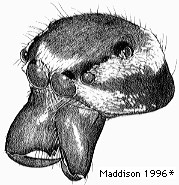 1
1
 2
2
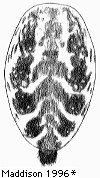 3
3
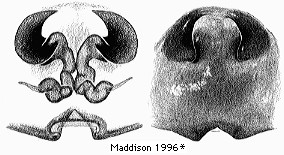 4
4
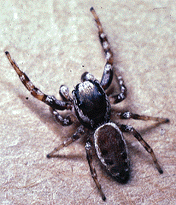 5
5
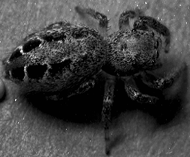 6
6- Male face
- Palpus
- Female abdomen
- Epigynum
- Male (Bedford, MA)
- Female (Spanish R.,ON)
Natural History
Found on various trees and shrubs, usually in or near forests; less often found in fields and on herbs than is P. galathea. Dondale (1961) describes the life history of P. proterva in Nova Scotia.Distribution
Across much of Canada and northeastern United States, south in the east to Florida and Texas.About This Page
Included on this page are images and text from Maddison, W.P. 1996. Pelegrina Franganillo and other jumping spiders formerly placed in the genus Metaphidippus (Araneae: Salticidae). Bulletin of the Museum of Comparative Zoology. l54(4): 215-368. These images and text are copyright © 1996 The President and Fellows of Harvard CollegePage copyright © 1995 Wayne Maddison
All Rights Reserved.
Citing this page:
Tree of Life Web Project. 1995. Pelegrina proterva . Version 01 January 1995 (under construction). http://tolweb.org/Pelegrina_proterva/5043/1995.01.01 in The Tree of Life Web Project, http://tolweb.org/






 Go to quick links
Go to quick search
Go to navigation for this section of the ToL site
Go to detailed links for the ToL site
Go to quick links
Go to quick search
Go to navigation for this section of the ToL site
Go to detailed links for the ToL site